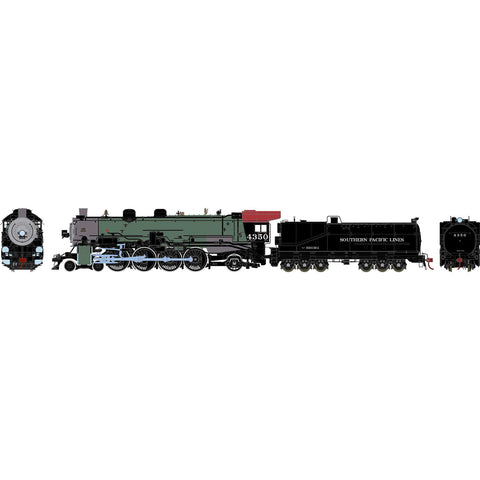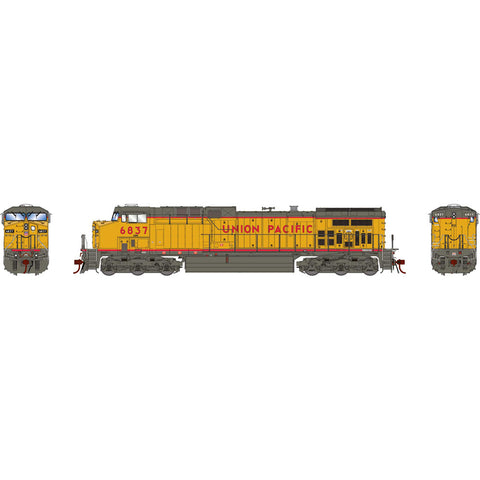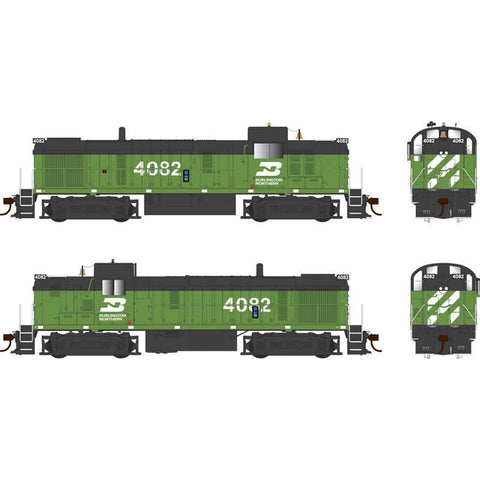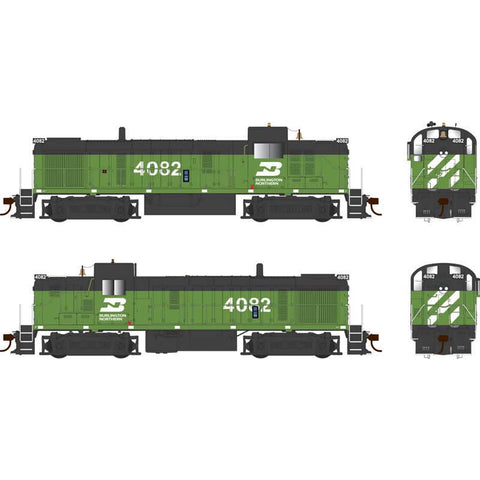
HO 4-8-2 MT-4 DCCR SP #4357
ITEM NUMBER: ATHG71556
Overview
The first North American 4-8-2 locomotives were built by the American Locomotive Company (ALCO) for the Chesapeake and Ohio Railway (C&O) in 1911, for heavy mountain service (hence the popular name, (“Mountain Type”). Southern Pacific joined the parade in October 1923, when it took delivery of ten new 4-8-2 locomotives, class Mt-1, from Alco. They were numbered in the new 4300 series as #4300-4309 and were put to work on the Sunset and Golden State routes. They were an instant hit; SP promptly signed with Alco for eighteen more (#4310-4327) for delivery in March 1924.
Meanwhile, the art of locomotive manufacturing was evolving as specialized steel manufacturers learned how to create ever-larger and more complex steel castings. SP took note of these developments and performed cost studies to evaluate the possibility of building 4-8-2s in the shops at Sacramento. The numbers were all favorable and a project was approved to build eighteen class Mt-3 4-8-2s (#4328-4345) in-house. Sacramento began work, with #4328 approved for service in September 1925. The last Mt-3, #4345, entered service on June 16, 1926.
Business continued to boom and trains kept growing—the SP’s Board of Directors approved a new program to build another 21 similar machines, #4346-4366. These locomotives would be class Mt-4.
Many of the Mt-4s assigned to operating districts with snowsheds were fitted with SP’s distinctive “clamshell” exhaust deflector. Their most important visual modification took place beginning in 1939, when they were fitted with sheet-steel “skyline casings,” similar to those on the new Lima 4-8-4s, that were developed to help direct exhaust smoke atop the boiler, away from the locomotive cab.
Still another visual treat was available for five short years, when #4350, 4352, 4353, 4361 and 4363 were partially repainted in Daylight red and orange for service on the San Joaquin Daylight. The tenders were completely painted, but only the cab area received vivid colors. The new paint was applied in 1946, approximately the same time that tender lettering standards were changed from “Southern Pacific Lines” to “Southern Pacific.” After 1951, all five engines were repainted in black and re-entered normal pool service.
As the 1950s progressed, new diesels were taking over more freight and through passenger assignments, leaving SP with a surplus of relatively modern steam power. A few Mt-4s were still operating into the fall of 1956. The final day for steam on Commutes was January 22, 1957, but SP clerks didn’t get around to preparing formal retirement papers for the last five Mt-4s until after diesels had completely taken over.
The SP began building their MT-4 class 4-8-2 Mountain’s in their Sacramento Shops in 1926. As-delivered they came with green boilers, which lasted until the early to mid-1930’s. They were then painted the standard black scheme.
ROAD NUMBER SPECIFIC FEATURES:
- Standard paint scheme
- Boiler Tube pilot
- Alligator style crosshead
- 120-C-6 tender. Mid-1930-1940
STEAM LOCOMOTIVE FEATURES:
- With or without Skyline casing
- Metal handrails
- Builder’s plates
- Cab interior details
- Non-operating classification lights
- Blackened metal wheels
- Adjustable cab windows and doors
- Lighted number boards
- Firebox with rivet detail
- Adjustable Cab hatch
- Laird multiple bearing cross head, where applicable
- Factory applied detail parts, including:
- Brass-painted bell and whistle piping
- valves generator
- steps air pump
- air tanks reverser
- coupler lift bar
- Front coupler pocket able to accept an operating coupler
- See-through running boards with safety tread detail
- Boiler backhead with full details and printed gauges
- McHenry operating scale knuckle couplers
- Minimum radius: 22”
- Era: 1926 - 1958
NEW FEATURES:
- Dual cube speakers for great sound quality
- Upgraded headlight lighting with LED
- Improved loco-to-tender connection harness for increased durability and serviceability
- Improved electrical pick up wipers
- Improved traction tire-to-rail contact area
SPECIFICATIONS:
- DCC: Ready/21-Pin NEM
- Era: 1911-1940, 1941-1970
- Lighting: LED
- Prototype Manufacturer: American Locomotive Company (ALCO)
- Reporting Mark: SP
- Scale: HO
- Sound: Ready
- Wheel Configuration: 4-8-2
We Also Recommend





